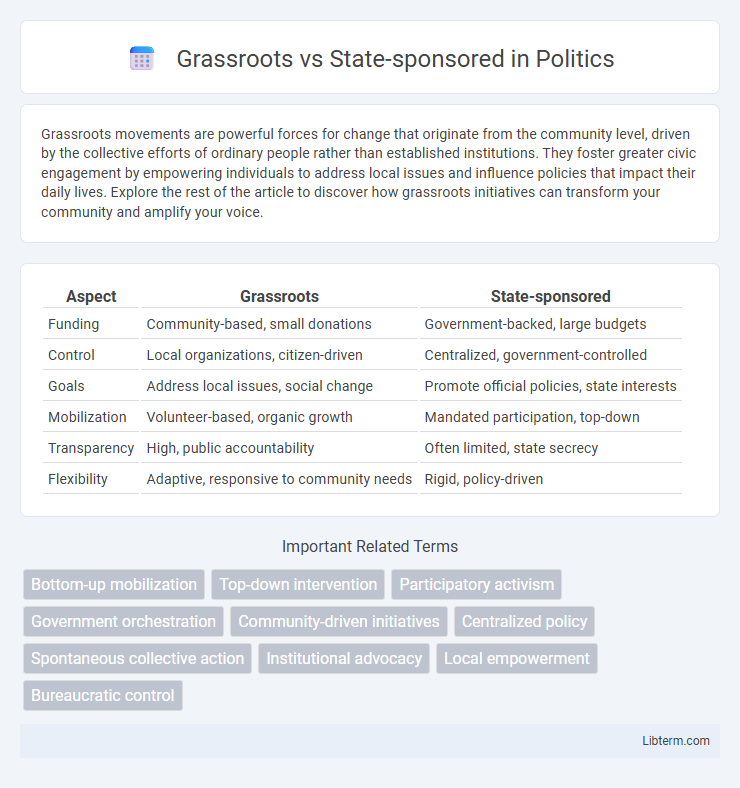Grassroots movements are powerful forces for change that originate from the community level, driven by the collective efforts of ordinary people rather than established institutions. They foster greater civic engagement by empowering individuals to address local issues and influence policies that impact their daily lives. Explore the rest of the article to discover how grassroots initiatives can transform your community and amplify your voice.
Table of Comparison
| Aspect | Grassroots | State-sponsored |
|---|---|---|
| Funding | Community-based, small donations | Government-backed, large budgets |
| Control | Local organizations, citizen-driven | Centralized, government-controlled |
| Goals | Address local issues, social change | Promote official policies, state interests |
| Mobilization | Volunteer-based, organic growth | Mandated participation, top-down |
| Transparency | High, public accountability | Often limited, state secrecy |
| Flexibility | Adaptive, responsive to community needs | Rigid, policy-driven |
Defining Grassroots and State-Sponsored Movements
Grassroots movements originate from local communities driven by collective action and shared concerns, emphasizing bottom-up organization without centralized control. State-sponsored movements are orchestrated or heavily supported by government entities, leveraging official resources and institutional power to achieve strategic objectives. Understanding these distinctions highlights differences in motivation, organizational structure, and influence within social and political contexts.
Origins and Motivations Behind Each Approach
Grassroots movements typically originate from local communities driven by shared concerns such as social justice, environmental protection, or human rights, relying on collective action and volunteer support to address issues directly impacting their members. State-sponsored initiatives often emerge from government agencies with motivations rooted in policy implementation, national security, or economic development, leveraging institutional resources and formal authority to achieve broader strategic objectives. The fundamental difference lies in grassroots efforts being bottom-up and community-driven, while state-sponsored actions are top-down and centrally coordinated.
Organizational Structures: Decentralized vs. Centralized
Grassroots movements feature decentralized organizational structures, allowing local groups autonomy and flexible decision-making processes that foster community engagement and rapid adaptation. State-sponsored organizations operate under centralized hierarchies, enabling coordinated resource allocation, unified messaging, and strategic control from top leadership. The contrast between decentralized and centralized models significantly impacts effectiveness, responsiveness, and scalability within political and social campaigns.
Funding Sources and Resource Allocation
Grassroots movements typically rely on small donations, volunteer support, and local fundraising efforts, resulting in limited but highly engaged resources directed toward community-specific initiatives. State-sponsored organizations receive substantial government funding, enabling broad resource allocation across various programs with centralized oversight. The disparity in funding sources significantly impacts the scale, reach, and operational capacity between grassroots and state-sponsored entities.
Community Engagement and Participation
Grassroots movements drive community engagement through localized, bottom-up participation, fostering direct involvement and empowerment of residents in decision-making processes. State-sponsored initiatives often utilize top-down approaches, channeling resources and policies to mobilize broader participation but may face challenges in sustaining authentic community ownership. Effective community engagement hinges on balancing grassroots authenticity with state support to ensure inclusive, impactful participation across diverse populations.
Strategies for Achieving Objectives
Grassroots movements prioritize community engagement and localized activism to build widespread support, leveraging social networks and direct action to influence change. State-sponsored efforts employ top-down strategies, utilizing governmental authority, resources, and formal channels to implement policies and control messaging. Both approaches differ in scale and methods, with grassroots focusing on mobilizing public participation and state-sponsored strategies emphasizing institutional power and coordination.
Impact and Effectiveness: Comparative Analysis
Grassroots movements often generate strong community engagement and authentic advocacy, leading to sustainable social change through local participation and empowerment. State-sponsored initiatives benefit from substantial resources and policy influence, enabling wide-reaching implementation but sometimes facing challenges in community trust and adaptability. Comparative analyses reveal grassroots efforts excel in fostering deep behavioral shifts, while state-sponsored programs achieve broader coverage and rapid systemic impact.
Challenges and Limitations Faced
Grassroots movements often struggle with limited funding, lack of formal organization, and difficulties gaining widespread media attention, which restrict their scalability and influence. State-sponsored initiatives face challenges such as bureaucratic inefficiencies, political agendas that may overshadow genuine community needs, and resistance from marginalized groups skeptical of government motives. Both models encounter obstacles in ensuring sustained engagement and balancing diverse stakeholder interests to achieve meaningful social or political change.
Case Studies: Notable Grassroots and State-Sponsored Examples
Notable grassroots movements such as the Arab Spring exemplify citizen-led demands for political reform, highlighting the power of decentralized activism driven by social media and local organizing. In contrast, state-sponsored campaigns like China's Great Firewall showcase government-controlled efforts to regulate information and suppress dissent through sophisticated censorship technologies. These case studies reveal distinct strategies where grassroots initiatives prioritize collective mobilization while state-sponsored actions emphasize top-down control and surveillance mechanisms.
Future Trends and Evolving Dynamics
Grassroots movements increasingly leverage social media platforms and decentralized networks to mobilize support rapidly, signaling a shift toward more organic, bottom-up activism. State-sponsored initiatives continue to evolve through advanced surveillance technologies and strategic information campaigns, aiming to influence both domestic and international public opinion. The tension between these approaches highlights future trends in governance and civil resistance, emphasizing the growing importance of digital tools and information control in political dynamics.
Grassroots Infographic

 libterm.com
libterm.com